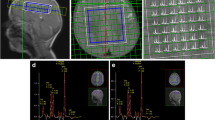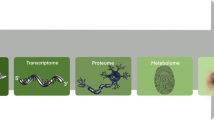Abstract
Purpose
The detection and quantification of metabolites relevant for the diagnosis of fatal metabolic disorders by proton magnetic resonance spectroscopy (1H-MRS) was recently demonstrated. This prospective study aimed to compare the concentrations of beta-hydroxybutyrate (BHB), glucose (GLC), and lactate (LAC) derived from both biochemical analyses and 1H-MRS for the diagnosis of fatal metabolic disorders.
Methods
In total, 20 cases with suspected fatal metabolic disorders were included in the study. For the agreement based on thresholds, the concentrations of BHB and GLC in the vitreous humor (VH) from the right vitreous and in cerebrospinal fluid (CSF) from the right lateral ventricle were derived from 1H-MRS and biochemical analyses. The predefined thresholds for pathological elevations were 2.5 mmol/l for BHB and 10 mmol/l for GLC based on the literature. In addition, concentrations of the same metabolites in white matter (WM) tissue from the corona radiata of the right hemisphere were analyzed experimentally using both methods. To enable the biochemical analysis, a dialysate of WM tissue was produced. For all three regions, the LAC concentration was determined by both methods.
Results
The conclusive agreement based on thresholds was almost perfect between both methods with only one disagreement in a total of 70 comparisons due to the interference of a ferromagnetic dental brace. The differences in the concentrations between both methods showed high standard deviations. Confidence intervals of the bias not including 0 were found in CSF-GLC (− 3.1 mmol/l), WM-GLC (1.1 mmol/l), and WM-LAC (− 6.5 mmol/l).
Conclusion
Despite a considerable total error attributable to both methods, MRS derives the same forensic conclusions as conventional biochemical analyses. An adaptation of the protocol to reduce the detected errors and more data are needed for the long-term validation of MRS for the diagnosis of fatal metabolic disorders. The production of WM dialysates cannot be recommended due to high glycolytic loss.



Similar content being viewed by others
Abbreviations
- DM1:
-
Diabetes mellitus type 1
- DM2:
-
Diabetes mellitus type 2
- DKA:
-
Diabetic ketoacidosis
- HHS:
-
Hyperosmolar hyperglycemic state
- 1H-MRS:
-
Proton magnetic resonance spectroscopy
- BCA:
-
Biochemical analysis
- VH:
-
Vitreous humor
- CSF:
-
Cerebrospinal fluid
- WM:
-
White matter
- BHB:
-
Beta-hydroxybutyrate
- GLC:
-
Glucose
- LAC:
-
Lactate
- AcAc:
-
Acetoacetate
- MM:
-
Macromolecules
- TR:
-
Repetition time
- SD:
-
Standard deviation
References
Thomsen JL, Felby S, Theilade P, Nielsen E (1995) Alcoholic ketoacidosis as a cause of death in forensic cases. Forensic Sci Int 75(2–3):163–171
Laffel L (1999) Ketone bodies: a review of physiology, pathophysiology and application of monitoring to diabetes. Diabetes Metab Res Rev 15(6):412–426
Gagajewski A, Murakami MM, Kloss J, Edstrom M, Hillyer M, Peterson GF, Amatuzio J, Apple FS (2004) Measurement of chemical analytes in vitreous humor: stability and precision studies. J Forensic Sci 49(2):1–4
Custer EM, Myers JL, Poffenbarger PL, Schoen I (1983) The storage stability of 3-hydroxybutyrate in serum, plasma, and whole blood. Am J Clin Pathol 80(3):375–380
Morris AAM (2005) Cerebral ketone body metabolism. J Inherit Metab Dis 28(2):109–121
Elliott S, Smith C, Cassidy D (2010) The post-mortem relationship between beta-hydroxybutyrate (BHB), acetone and ethanol in ketoacidosis. Forensic Sci Int 198(1):53–57
Sadones N, Lambert WE, Stove CP (2017) The (non) sense of routinely analysing beta-hydroxybutyric acid in forensic toxicology casework. Forensic Sci Int 274:38–43
Hockenhull J, Dhillo W, Andrews R, Paterson S (2012) Investigation of markers to indicate and distinguish death due to alcoholic ketoacidosis, diabetic ketoacidosis and hyperosmolar hyperglycemic state using post-mortem samples. Forensic Sci Int 214(1):142–147
Traub F (1969) Methode zur Erkennung von todlichen Zuckerstoff-wechselstorungen an der Leiche: Diabetes mellitus und Hypoglykamie. Zbl Allg Path 112:390–399
Palmiere C, Sporkert F, Vaucher P, Werner D, Bardy D, Rey F, Lardi C, Brunel C, Augsburger M, Mangin P (2012) Is the formula of Traub still up to date in antemortem blood glucose level estimation? Int J Legal Med 126(3):407–413
Zilg B, Alkass K, Berg S, Druid H (2009) Postmortem identification of hyperglycemia. Forensic Sci Int 185(1):89–95
Palmiere C, Mangin P (2013) Postmortem biochemical investigations in hypothermia fatalities. Int J Legal Med 127(2):267–276
Kanetake J, Kanawaku Y, Mimasaka S, Sakai J, Hashiyada M, Nata M, Funayama M (2005) The relationship of a high level of serum beta-hydroxybutyrate to cause of death. Legal Med 7(3):169–174
Palmiere C, Mangin P (2012) Postmortem chemistry update part I. Int J Legal Med 126(2):187–198
Luna A (2009) Is postmortem biochemistry really useful? Why is it not widely used in forensic pathology? Legal Med 11:S27–S30
Madea B, Musshoff F (2007) Postmortem biochemistry. Forensic Sci Int 165(2):165–171
Garland J, Philcox W, Kesha K, Morrow P, Lam L, Spark A, Palmiere C, Elstub H, Cala AD, Stables S (2018) Differences in sampling site on postmortem cerebrospinal fluid biochemistry: a preliminary study. Am J Forensic Med Pathol 39(4):304–308
Palmiere C, Mangin P, Werner D (2014) Postmortem distribution of 3-beta-hydroxybutyrate. J Forensic Sci 59(1):161–166
Heimer J, Gascho D, Chatzaraki V, Knaute DF, Sterzik V, Martinez RM, Thali MJ, Zoelch N (2018) Postmortem 1 H-MRS—detection of ketone bodies and glucose in diabetic ketoacidosis. Int J Legal Med 132(2):593–598
Heimer J, Gascho D, Fliss B, Martinez RM, Zoelch N (2018) Detection of elevated ketone bodies by postmortem 1H-MRS in a case of fetal ketoacidosis. J Forensic Legal Med 59:16–19
Simpson R, Devenyi GA, Jezzard P, Hennessy TJ, Near J (2017) Advanced processing and simulation of MRS data using the FID appliance (FID-A)—an open source, MATLAB-based toolkit. Magn Reson Med 77(1):23–33
Zoelch N, Hock A, Steuer AE, Heimer J, Kraemer T, Thali MJ, Gascho D (2019) In situ postmortem ethanol quantification in the cerebrospinal fluid by non-water-suppressed proton MRS. NMR Biomed 32(5):e4081
Boulagnon C, Garnotel R, Fornes P, Gillery P (2011) Post-mortem biochemistry of vitreous humor and glucose metabolism: an update. Clin Chem Lab Med 49(8):1265–1270
Belsey SL, Flanagan RJ (2016) Postmortem biochemistry: current applications. J Forensic Legal Med 41:49–57
Iten P, Meier M (2000) Beta-hydroxybutyric acid—an indicator for an alcoholic ketoacidosis as cause of death in deceased alcohol abusers. J Forensic Sci 45(3):624–632
Bland JM, Altman D (1986) Statistical methods for assessing agreement between two methods of clinical measurement. Lancet 327(8476):307–310
R Core Team (2019) R: a language and environment for statistical computing. R Foundation for Statistical Computing, Vienna https://www.R-project.org
Nelson T, Tung S (1987) Temperature dependence of proton relaxation times in vitro. Magn Reson Imaging 5(3):189–199
Behar KL, Rothman DL, Spencer DD, Petroff OA (1994) Analysis of macromolecule resonances in 1H NMR spectra of human brain. Magn Reson Med 32(3):294–302
Dacko M, Lange T (2019) Improved detection of lactate and β-hydroxybutyrate using MEGA-sLASER at 3 T. NMR Biomed e4100
Kugelberg FC, Jones AW (2007) Interpreting results of ethanol analysis in postmortem specimens: a review of the literature. Forensic Sci Int 165(1):10–29
Langer DL, Rakaric P, Kirilova A, Jaffray DA, Damyanovich AZ (2007) Assessment of metabolite quantitation reproducibility in serial 3D-1H-MR spectroscopic imaging of human brain using stereotactic repositioning. Magn Reson Med 58(4):666–673
Marshall I, Wardlaw J, Cannon J, Slattery J, Sellar RJ (1996) Reproducibility of metabolite peak areas in 1H MRS of brain. Magn Reson Imaging 14(3):281–292
Coe J, Apple F (1985) Variations in vitreous humor chemical values as a result of instrumentation. J Forensic Sci 30(3):828–835
Thierauf A, Musshoff F, Madea B (2009) Post-mortem biochemical investigations of vitreous humor. Forensic Sci Int 192(1):78–82
Blana SA, Mußhoff F, Hoeller T, Fimmers R, Madea B (2011) Variations in vitreous humor chemical values as a result of pre-analytical treatment. Forensic Sci Int 210(1):263–270
Felby S, Nielsen E (1994) Determination of ketone bodies in postmortem blood by head-space gas chromatography. Forensic Sci Int 64(2):83–88
Fung WK, Chan KL, Mok VKK, Lee CW, Choi VMF (2000) The statistical variability of blood alcohol concentration measurements in drink–driving cases. Forensic Sci Int 110(3):207–214
Chan A, Swaminathan R, Cockram C (1989) Effectiveness of sodium fluoride as a preservative of glucose in blood. Clin Chem 35(2):315–317
Clark ML, Humphreys SM, Frayn KN (1990) Stability of plasma glucose during storage. Ann Clin Biochem 27(4):373–377
Astles R, Williams CP, Sedor F (1994) Stability of plasma lactate in vitro in the presence of antiglycolytic agents. Clin Chem 40(7):1327–1330
Acknowledgments
We thank Roger Odermatt for the time-intensive production of the white matter dialysates. The authors express their gratitude to Emma Louise Kessler, MD, for her generous donation to the Zurich Institute of Forensic Medicine, University of Zurich, Switzerland.
Author information
Authors and Affiliations
Corresponding author
Ethics declarations
This article does not contain any studies with live human participants or animals performed by any of the authors. Ethical approval for the publication of case-related data was obtained by the Ethics Committee of the Canton of Zurich, Nr. KEK ZH-Nr. 15-0686.
Additional information
Publisher’s note
Springer Nature remains neutral with regard to jurisdictional claims in published maps and institutional affiliations.
Rights and permissions
About this article
Cite this article
Heimer, J., Gascho, D., Madea, B. et al. Comparison of the beta-hydroxybutyrate, glucose, and lactate concentrations derived from postmortem proton magnetic resonance spectroscopy and biochemical analysis for the diagnosis of fatal metabolic disorders. Int J Legal Med 134, 603–612 (2020). https://doi.org/10.1007/s00414-019-02235-6
Received:
Accepted:
Published:
Issue Date:
DOI: https://doi.org/10.1007/s00414-019-02235-6




